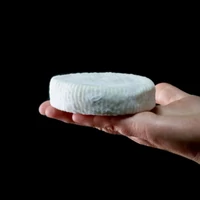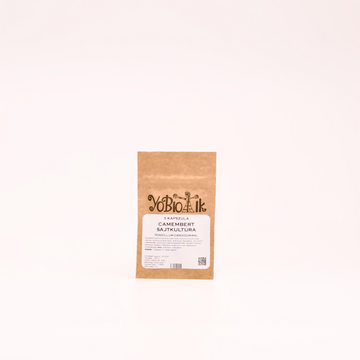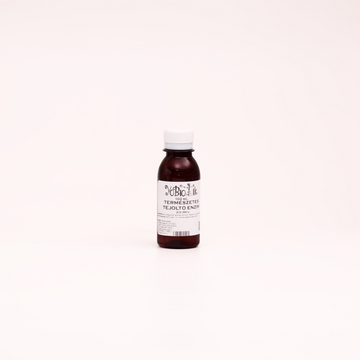Which was famous for it's cheese from the XVIII. century. Marie Harel local cheese master perfected the cheese, but it didn't have a name until Napoleon himself tasted it and named it "camembert" after it's origin. Thanks to the emperor the cheese became world famous.
The Camembert is a type of soft cheese. It ripens from the outside towards the inside, the ageing process takes about 3-4 weeks. A perfect camembert is almost liquid like, and covered with its beautiful white fur. Its smell reminds us to fresh mushrooms. The cheese starts out the same as most soft cheeses, the difference comes with the ageing. The process requires high humidity, a temperature of 13-14 °C and fresh oxygen (the air must be circulated). Because of the mould I recommend to age it separately from other cheeses.
Camembert making package, that has everything you need
How to make Camembert at home:
INGREDIENTS:
- 10 litres milk
- 1 capsule Camembert Cheese CapCulture
- 2 ml Natural Rennet (220 IMCU)
- 1-1.5 g Calcium-Chloride
- iodine free salt (cheese salt)
The recipe: It's made from high quality whole milk, originally camembert was only made from sheep's milk.
Nowadays the cheese is made from cow, goat, sheep's milk or a mixture of them.
It can be made both from raw and pasteurised milk.
Pasteurisation: If you want to pasteurise you milk, heat it to 63-65 °C and keep it there for 30 minutes,
OR heat the milt to 72-74 °C and keep it for 20 seconds.
After that cool it back to culturing temperature (30-32 °C), then dissolve 1-1.5 grammes of calcium-chloride in it.
Moderate pasteurisation is recommended, you can read about it here.
Use a kitchen thermometer for your measurements.
1. CULTURING: Our new Camembert culture also contains Geotrichum!
Start heating your milk in a pot. While heating pour the content of a Camembert culture capsule into a small bowl and dissolve it in a bit of lukewarm water.
When the milk reaches 30-32 °C add the dissolved culture.
This is when you have to add the calcium chloride too.
Let the mixture rest for 15 minutes.
2. COAGULATION: Add 2 ml of rennet (220 IMCU) for every 10 litres of milk, Stir well for 1/2-1 minutes.
Cover the milk and let it sit for 40-45 minutes, until it becomes a solid curd. While waiting sanitise your cheese moulds in boiling water.
3. CUTTING THE CURD: Gently touch the curd with your palm to see if it solidified or not.
If it's nice and firm, cut it to 3-4 cm curds with a curd knife under 8-10 minutes.
Some people doesn't cut the curd to smaller pieces, that way more whey stays in the curd, which makes it harder to work with.
It's worth trying both methods to see what's the difference, which you like more.
4. SEDIMENTATION: 15-20 minutes of sedimentation is the next step. Put a lid on the pot so it doesn't gets cold.
During the process I usually gently stir it 1-2 times. It helps with the whey release.
5. SHAPING: Carefully scoop the curds into cheese moulds with a perforated spoon or colander.
Keep in mind that the cheese will reduce to the third of its volume in the mould, if you overfill them, the end product will still be perfect.
Since the curds at this point are very soft, only flip the cheese after 35-40 minutes.
This is the hardest part of soft cheeses. Be careful and patient, the soft curd can easily fall apart.
I gently flip it almost completely inside the mould, by guiding it with my fingers.
During the next 24 hours repeat this 6-8 times more, so the moisture can leave the cheese evenly.
The curd will shrink to 1/3 of its size.
As the cheese get more and more dense, it will get less and less fragile, and easier to flip.
Make sure the room is 20-23 °C during this process.
6. SALTING: Put the cheese into a 12% (by weight) brine for 60-90 minutes for every 100 g, flip it half way through.
The salt can not contain any iodine! The brine should be 15-16°C!
7. DRYING: Let the surface dry for a day, so the mould can properly develop.
If it's too moist, the can get infected with other moulds.
16-18 °C is the ideal temperature, also the air shouldn't be too humid, or the cheese won't dry.
8. AGEING: Age the cheese on 13-14°C-, 95 % humidity, for 3 weeks.
After the first week white mould patches should appear, which will grow day after day.
Keep the camemberts on a cheese screen or mesh, and gently flip them every day.
It is very important for the humidity and the temperature to be precise during the ripening.
If it's not humid enough, the cheese will be dry and hard.
If the temperature is too high, the ageing will speed up and unwanted bacteria may infect the cheese, which makes it smelly and taste bad.
9. STORAGE: Keep it in a refrigerator, wrapped in aluminium foil for up to 2 weeks.
GOOD TO KNOW:
Bitter taste is a common error in soft cheeses, it is caused by too much whey staying in the cheese during pressing.
To fix this you have to increase the calcium content of your milk, usually with calcium-chloride.
It's a problem at the beginning of ageing, so long aged cheeses won't have this problem.
At the beginning of the ageing, the protein will breakdown into smaller polypeptides, which taste bitter.
Later the polypeptides will break down even wore to amino acids, which are sweet, making older cheeses sweeter.
In soft cheeses the breakdown is slower and they aren't aged for too long, so they are sensitive to this mistake.
Good luck and happy cheesemaking!
 Lactic cultures
Lactic cultures
 Ingredients
Ingredients
 Cheese moulds
Cheese moulds
 Supplies
Supplies
 Kits
Kits





